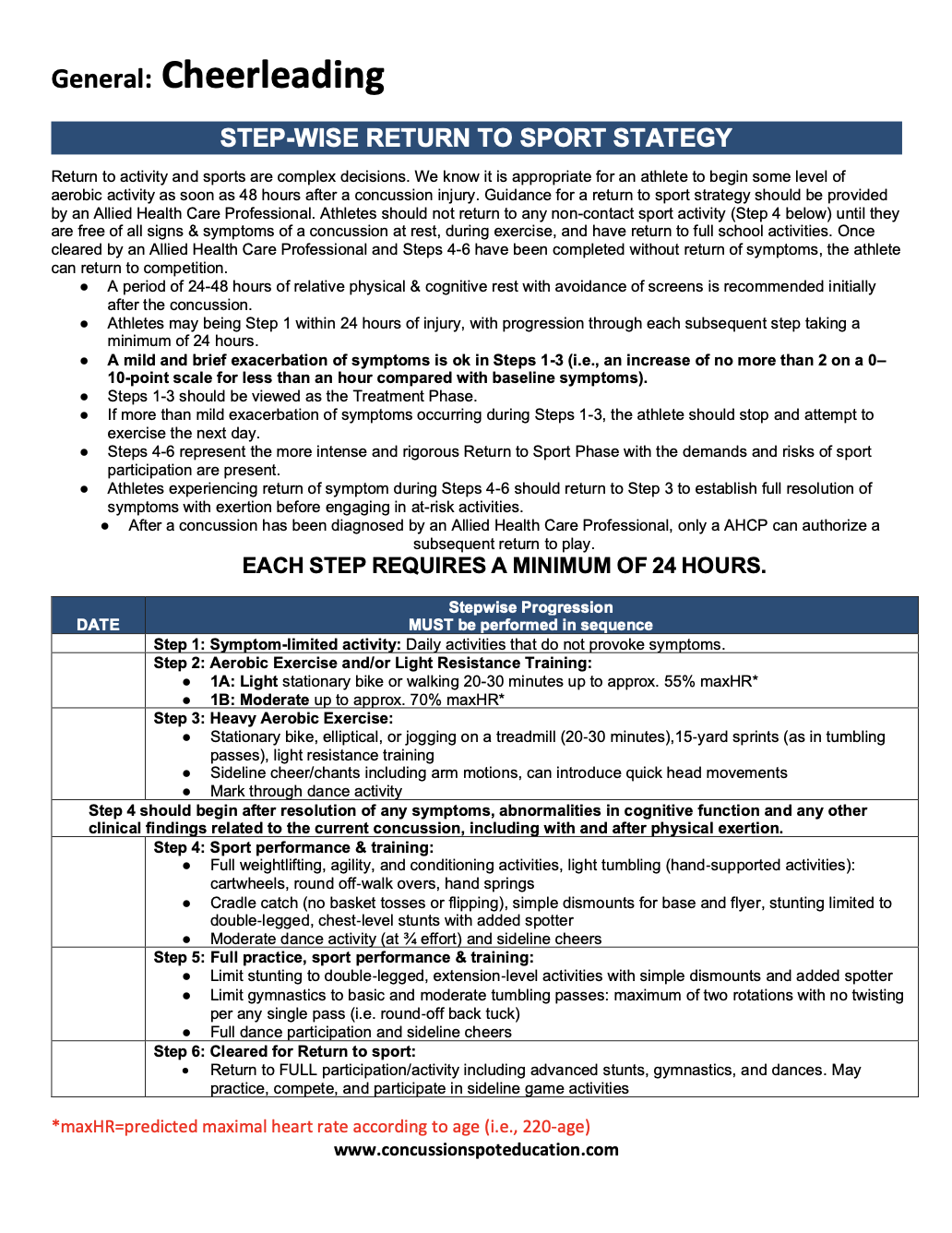

Cheerleading (General) Concussion RTP Protocol
The Cheerleading Concussion Return-to-Play (RTP) Protocol is a comprehensive, sport-specific recovery framework designed to help cheerleaders safely resume full participation following a concussion. Cheerleading is a physically demanding sport that involves high-impact stunts, tumbling, jumps, precise timing, and synchronization. Because of these complex movements and the risk of falls or collisions, concussion recovery must be carefully managed to protect athletes’ brain health while progressively rebuilding physical and cognitive function.
This protocol follows a stepwise progression, emphasizing gradual increase in activity intensity and complexity to ensure safe recovery. It begins with symptom-limited rest, where the cheerleader avoids activities that exacerbate symptoms but may perform light daily activities. Once symptoms stabilize, the protocol introduces light aerobic exercise—such as walking or stationary cycling—to enhance circulation and overall fitness without risking symptom recurrence.
As the athlete advances, off-mat cheer-specific drills focusing on balance, coordination, and strength are incorporated. These activities help restore neuromuscular control and body awareness without direct risk of head injury. Once the athlete remains symptom-free, controlled practice of non-contact skills is introduced. This includes basic motions, jumps, and tumbling drills performed without stunting or partner work.
The next phase involves gradual reintroduction of partner stunts and pyramids, starting with low height and limited complexity to minimize risk. Close monitoring ensures symptoms do not return during these more demanding activities. The final phase allows full participation in all cheerleading routines, including high-level stunts, tumbling, and performance, once the athlete is symptom-free both at rest and during exertion.
Throughout the process, a key rule is that the athlete must be symptom-free for at least 24 hours before progressing to the next stage. If symptoms recur, the cheerleader must return to the previous phase and rest before attempting to advance again. This cautious approach minimizes the risk of re-injury and supports long-term brain health.
Designed for athletes, coaches, trainers, and healthcare providers, the Cheerleading Concussion RTP Protocol provides a safe, evidence-based roadmap for returning to cheerleading confidently and effectively after a concussion.
The Cheerleading Concussion Return-to-Play (RTP) Protocol is a comprehensive, sport-specific recovery framework designed to help cheerleaders safely resume full participation following a concussion. Cheerleading is a physically demanding sport that involves high-impact stunts, tumbling, jumps, precise timing, and synchronization. Because of these complex movements and the risk of falls or collisions, concussion recovery must be carefully managed to protect athletes’ brain health while progressively rebuilding physical and cognitive function.
This protocol follows a stepwise progression, emphasizing gradual increase in activity intensity and complexity to ensure safe recovery. It begins with symptom-limited rest, where the cheerleader avoids activities that exacerbate symptoms but may perform light daily activities. Once symptoms stabilize, the protocol introduces light aerobic exercise—such as walking or stationary cycling—to enhance circulation and overall fitness without risking symptom recurrence.
As the athlete advances, off-mat cheer-specific drills focusing on balance, coordination, and strength are incorporated. These activities help restore neuromuscular control and body awareness without direct risk of head injury. Once the athlete remains symptom-free, controlled practice of non-contact skills is introduced. This includes basic motions, jumps, and tumbling drills performed without stunting or partner work.
The next phase involves gradual reintroduction of partner stunts and pyramids, starting with low height and limited complexity to minimize risk. Close monitoring ensures symptoms do not return during these more demanding activities. The final phase allows full participation in all cheerleading routines, including high-level stunts, tumbling, and performance, once the athlete is symptom-free both at rest and during exertion.
Throughout the process, a key rule is that the athlete must be symptom-free for at least 24 hours before progressing to the next stage. If symptoms recur, the cheerleader must return to the previous phase and rest before attempting to advance again. This cautious approach minimizes the risk of re-injury and supports long-term brain health.
Designed for athletes, coaches, trainers, and healthcare providers, the Cheerleading Concussion RTP Protocol provides a safe, evidence-based roadmap for returning to cheerleading confidently and effectively after a concussion.
